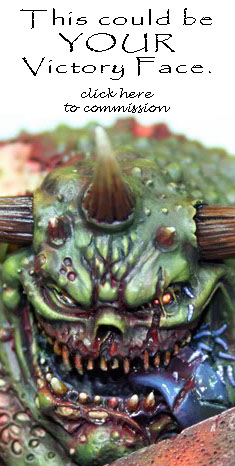Begin by covering the slot with a piece of card and some super glue. Mix up some putty and press it down on to your work surface. Use a sheet of paper or something you don't mind throwing away afterwards.
Now to start applying the putty. Using the "spoon" end of the sculpting tool, scoop small clumps of putty and smear it onto the base. The more clumps, the better. Don't use any water or lubricant. Milliput has a tendency to crumble when your sculpting tool is too dry, and we want to capitalize on this.
I like to start in the center and work my way towards the edge. In addition to making these clumps, I like to lightly drag the sculpting tool over the surface in some areas. This creates more cracking and texture. If you do this right you won't need to add any sand or other textures to the base.
You can see some of the base showing through on the right hand side. That's fine. It will help create more depth if there are a few spots like that. When the base is fully covered, add a few extra clumps here and there.
Now that the base is covered with clumps and texture, we want to smooth some of them. Clean off your sculpting tool with a paper towel (you will probably find that there has been some buildup of putty). With a little bit of water on your tool, gently smooth down some of the lumps and high points. Use a side-to-side or circular motion. We want to keep those cracks between each clump, so be careful not to press down too hard with the tool.
Smoothing complete. Now take a needle tool and trace some of the cracks between the clumps. Don't overdo it. In this case, less is more. Follow the pre-existing cracks, improvise a little, and you can create a really natural effect. Once you have finished adding extra cracks, take the GW sculpting tool again and press down on some of the clumps near the edges, to help close in some of the cracks. This helps create some irregularity in the width of the cracks. You don't want them all the same thickness.
Finished base! Paint it in your favorite desert color scheme and add some light brown/dead static grass.
In case you are curious, the color recipe for the finished base here is:
Calthan Brown, Graveyard Earth, Bubonic Brown, Menoth White Base, Gryphonne Sepia Wash, Menoth White Base. GW dead static grass.












Now that is a great little tutorial! Good on you, man. I'm adding you to my blog roll.
ReplyDeleteI've got some blood bowl and sculpting stuff on my blog too (nowhere near as impressive, though.)
mdarrow.blogspot.com
Hey Matt,
ReplyDeleteIf you don't mind me asking how did you paint this base? Did you use washes or was this drybrushing all the way through?
Hi Jeff,
Delete"Calthan Brown, Graveyard Earth, Bubonic Brown, Menoth White Base, Gryphonne Sepia Wash, Menoth White Base. GW dead static grass."
It was all drybrushing using the colors above, with the exception of a Sepia wash, and then thin highlights of Menoth White Highlight. The colors are listed in the order I used them.
Hope this helps!
-Matt